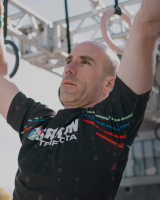The Official Training Blueprint to Help You Build an Unbreakable Body and Mind

Over more than a decade, Spartan founder and CEO Joe De Sena and thousands of Spartan coaches across the world have developed and refined a training philosophy, methodology, and system that builds tough people. And truly tough people train to be ready for anything. That means that when you're training to be unbreakable, there will be strength, speed, skill, and – of course – endurance.
The following is the basics of what you’ll likely find in any Spartan Training program.
Functional Fitness and Obstacle Race Training Tips That Will Make You Unbreakable
1. Cross Training
Obstacle course racing isn’t a one-dimensional sport or discipline. Racers are required to be able to run, jump, climb, carry, crawl, and run some more. One of the single best ways to prepare for an environment like that is to simulate the scenario, and cross training does just that. You’re challenged with a variety of different movements with either your own bodyweight or with weights and high intensities. Your heart rate will be elevated and other muscle groups will be taxed at the same time — a perfect simulation for what you’ll experience on race day.
2. Long, Slow, Distance Cardio (LSD)
Inspired by Spartan CEO Joe De Sena's intense training, incorporating long, slow, distance cardio (or LSD for short) can benefit all racers each week because it’s primarily an endurance-building workout. Long and slow runs help build a strong base for racers. Not only does it train racers to be able to physically handle longer distances, but it also forges a more resilient mindset for when things get tough. Racing aside, LSD cardio also puts the runner squarely in the zone 2 heart rate range, which is very beneficial to overall heart health.
3. Speed, Agility, and Quickness (SAQ)
Speed, agility, and quickness (SAQ) training is essential for any obstacle course racer. Similar to cross training, SAQ training helps to develop the necessary physical skills for navigating a course quickly and efficiently, such as tackling obstacles and carrying out movements like jumping, climbing, and crawling. SAQ training blocks will also help to improve coordination and balance, as well as decrease reaction time.
4. Obstacle Proficiency
Cross training, SAQ, and LSD cardio will get anyone race-ready, but when it comes to the obstacles, nothing will help shave off time more than dedicating time to obstacle proficiency. Practicing on race-specific obstacles (or even just similar obstacles) can help racers become more familiar with what they may actually encounter during a race, allowing them to be better prepared and increase their chances of success. Ultimately, practicing obstacle proficiency is essential for obstacle course racers who want to succeed in the sport, and Spartan coaches are the industry’s best mentors for getting the job done as safely and efficiently as possible.
5. Active Recovery
Active recovery is a critical piece of every racers' routine, and Spartan coaches know exactly when, where, and how to add it into a program. Active recovery involves low-intensity exercise such as walking, swimming, or cycling. This type of exercise helps to reduce muscle soreness, increase blood flow, and flush out metabolic waste. Active recovery is more beneficial than complete rest because it keeps your blood flowing, but at a low enough intensity that it doesn’t overtax the body.











